I still remember the first time I tried to scrape web data for a side project—armed with nothing but a Python script, a cup of coffee, and a lot of misplaced optimism. One website redesign later, my code was toast and my caffeine buzz had turned into a headache. Fast forward to 2025, and the landscape has changed dramatically. Now, AI-powered web scrapers can turn even the messiest website into a neat spreadsheet in minutes, no coding required. It’s like having a super-powered intern who never asks for a raise or forgets to show up on Monday.
If you’re in sales, marketing, ecommerce, or just a data nerd like me, you’ve probably noticed: the web is now the world’s biggest database. But getting that data—accurately, quickly, and without pulling your hair out—used to be a real challenge. Not anymore. AI scrapers are making data extraction accessible to everyone, not just developers. In this guide, I’ll walk you through the top 15 AI web scraping tools for 2025, breaking down their features, pros and cons, and the best use cases. Whether you want to automate lead generation, monitor prices, or just stop copy-pasting, there’s a tool here for you.
How We Evaluated the Best AI Scrapers for Data Extraction
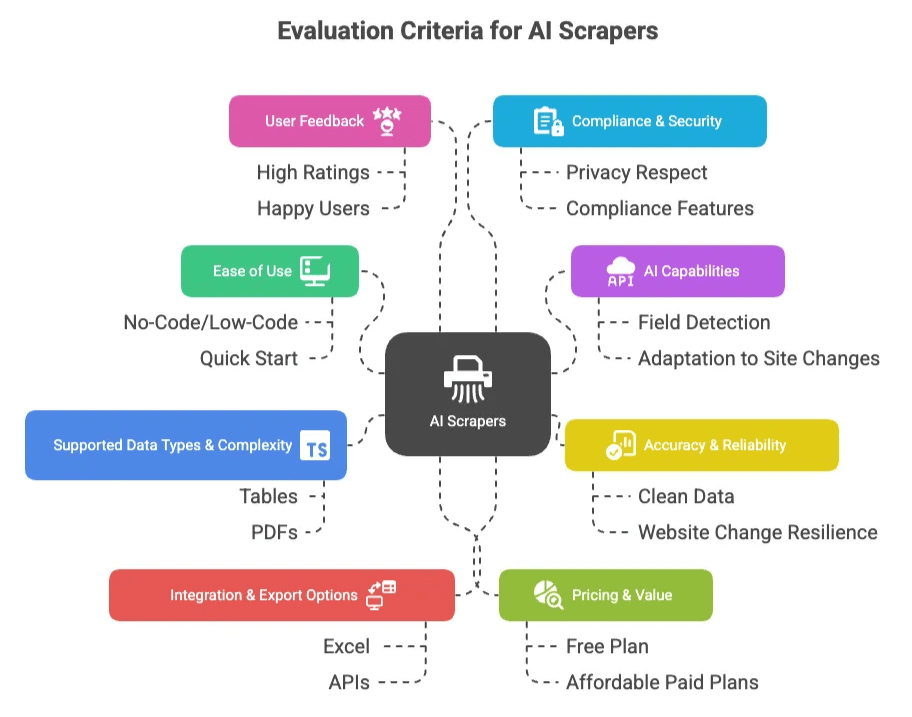
Before we get into the list, let’s talk about how I picked these tools. I’ve spent years in SaaS and automation, and I know the pain points—so I looked for scrapers that actually solve them. Here’s what I considered:
- Ease of Use: Is the tool truly no-code or low-code? Can a non-technical user get started quickly, or do you need a PhD in XPath?
- AI Capabilities: Does the scraper use AI for field detection, adapting to site changes, or extracting meaning from messy data? The more the AI does the heavy lifting, the better.
- Accuracy & Reliability: How well does the tool deliver clean, structured data? Does it keep working when websites change, or does it break at the first sign of trouble?
- Supported Data Types & Complexity: Can it handle tables, lists, images, PDFs, logins, infinite scroll, and multi-step workflows? Scalability matters too—can it scrape thousands of pages if needed?
- Integration & Export Options: Does it play nicely with Excel, Google Sheets, Airtable, Notion, APIs, or other business tools? The less manual work, the better.
- Pricing & Value: Is there a free plan or trial? Are paid plans affordable for the features and limits provided? Any sneaky hidden costs?
- User Feedback: I checked reviews on G2, Capterra, Trustpilot, and Chrome Store. Tools with high ratings and happy users got a boost; those with common complaints got a closer look.
- Compliance & Security: Does the tool respect privacy, handle sensitive data responsibly, and offer compliance features for enterprise users?
By weighing all these factors—and yes, reading way too many user reviews—I narrowed it down to the 15 AI scrapers below. Each one brings something unique to the table, whether you’re a non-technical business user or a developer building the next big thing.
Quick Comparison Table: Top 15 AI Scrapers at a Glance
Here’s a side-by-side look at the top contenders. For a deeper dive into each, keep scrolling!
| Tool | Key Features (AI & Automation) | Best For | Pros | Cons | Free Plan? |
|---|---|---|---|---|---|
| Thunderbit | Chrome extension, AI Suggest Fields, subpage & pagination, instant exports, AI data cleaning | Non-technical teams, sales, ecommerce, real estate | Easiest to use, fast setup, free exports | Free tier limited, less flexible for coders | Yes |
| Octoparse | Visual workflow, AI templates, cloud/local, logins, scheduling | Analysts, researchers, semi-technical users | Powerful, handles complex sites, big template lib | Learning curve, cloud costs extra | Yes |
| Browse AI | Point-and-click robots, AI adapts to changes, scheduling, monitoring, integrations | Business users, recurring data/monitoring | Easy setup, Google Sheets integration, alerts | Usage-based pricing, not as granular for devs | Yes |
| Bardeen | Chrome extension, AI playbooks, workflow automation, GPT-4, spreadsheet integration | Power users, marketers, automating multi-step tasks | Automates scraping + actions, free tier | Steep learning curve for complex flows | Yes |
| ScrapeStorm | AI Smart/Flowchart modes, cross-platform, proxies, scheduling, visual interface | Beginners & advanced users, e-commerce, research | Visual, built-in proxies, flexible | Advanced features less beginner-friendly | Yes |
| ScrapingBee | API-first, AI extraction, proxy handling, headless browser | Developers, data engineers, large-scale projects | Developer-friendly, scalable, AI parsing | No-code users need not apply | Limited trial |
| Import.io | ML extractors, screenshot capture, chaining, scheduling, compliance | Enterprises, high-volume, compliance-focused teams | Scalable, managed services, compliance features | Expensive, overkill for small jobs | No |
| ParseHub | Visual desktop app, dynamic content, conditional logic, scheduling (paid) | Semi-technical users, researchers, complex sites | Handles tricky sites, free tier | Clunky UI, learning curve, no built-in proxies | Yes |
| Kadoa | No-code AI, self-healing, real-time monitoring, data cleaning | Finance, e-commerce, job data, continuous monitoring | Self-healing, fast alerts, data normalization | Expensive, evolving feature set | Trial |
| Scrapy | Python framework, custom spiders, scalable, open source | Developers, engineers, custom projects | Free, flexible, massive community | Coding required, DIY maintenance | Yes |
| Webscraper.io | Browser extension, point-and-click, community sitemaps, cloud option | Beginners, simple data extraction | Free, easy, community support | No AI, limited for complex/dynamic sites | Yes |
| Diffbot | AI/NLP/computer vision, knowledge graph, structured APIs | Enterprises, research, media monitoring | No setup, broad coverage, knowledge graph | Expensive, less control for custom fields | Trial |
| AIScraper | Chrome extension, natural language prompts, presets, subpages, fast exports | Sales, lead gen, quick data tasks | Super fast, pay-as-you-go, easy for non-tech users | Not for huge jobs, browser-based | No (credits) |
| Gumloop | Visual AI workflow builder, Chrome recorder, integrations, AI nodes | Tech-savvy teams, custom automation, growth ops | Highly flexible, multi-step automations | Pricey, learning curve | Trial |
| scrapeless | AI scraping API, browser rendering, anti-bot, data cleaning, pay-per-success | Developers, scalable projects, enterprise | Simple API, robust anti-block, pay for success | Smaller community, some features enterprise-only | Trial |
| Oxylabs | API, 100M+ proxies, AI Copilot, anti-bot, analytics dashboard | Enterprises, technical teams, massive scale | Enterprise-grade, AI Copilot, 24/7 support | Expensive, not for small jobs | Trial |
Note: For more details on each tool—including pricing, user reviews, and best use cases—keep reading below.
What Is an AI Scraper and How Does It Work?
Let’s break it down. An AI scraper (or AI web scraper) is a tool that uses artificial intelligence to extract data from websites—automatically, and often with minimal setup. Unlike traditional web scrapers, which require you to specify exactly what to extract (think: “find the price in this HTML tag”), AI scrapers use machine learning, computer vision, and natural language processing to figure out what’s important on the page.
In plain English: you tell the AI scraper what you want (sometimes in natural language), and it finds the data for you—even if the website changes its layout or loads content dynamically. This means less time fiddling with selectors, more time getting actual work done.
Common use cases:
- Data collection: Pulling product info, prices, reviews, or news articles into a spreadsheet or database.
- Lead generation: Extracting contact info (emails, phone numbers) from directories or social media.
- Market research: Monitoring competitors, tracking trends, or aggregating job postings.
- Real-time monitoring: Setting up alerts for price changes, new listings, or breaking news.
AI scrapers can even handle things like infinite scroll, subpages, and dynamic content—stuff that used to break old-school scrapers. And because they’re smarter, they’re accessible to non-developers, not just the Python crowd.
Key Features to Look for in an AI Web Scraper
If you’re shopping for an AI scraper, here’s what should be on your checklist (and why):
- No-Code or Low-Code Interface: You want to spend time collecting data, not learning to code. Look for tools with point-and-click interfaces, browser extensions, or natural language prompts. This opens the door for your whole team—not just the IT folks.
- AI-Powered Field Detection & Structuring: The best tools automatically recognize tables, lists, prices, names, and more. This saves hours of manual setup and keeps working even if the website changes.
- Subpage & Pagination Support: Real-world data is rarely on one page. Good scrapers can follow “next” buttons, click into detail pages, and pull info from every layer—so you don’t miss half the data.
- Export & Integration Options: Can you export to Excel, Google Sheets, Airtable, Notion, or your CRM? The more integration options, the less time you’ll spend moving data around.
- Scheduling & Automation: Need fresh data every day? Look for built-in scheduling—set it and forget it.
- Dynamic Content & Anti-Bot Handling: Modern sites use JavaScript, infinite scroll, and anti-bot tricks. The best scrapers handle all that with headless browsers, proxies, and smart waiting.
- Data Cleaning & Post-Processing: Some tools can clean, format, or even translate data as they scrape—so you get analysis-ready results.
- Compliance & Security: Especially for enterprise users, features like audit logs, PII masking, and privacy controls matter.
- Scalability & Support: Can the tool handle thousands of pages? Is there good support or an active community if you get stuck?
The right mix depends on your needs—if you’re scraping a few pages for a one-off project, you might not need all the bells and whistles. But if you’re building a data pipeline for your business, these features will save you time (and headaches) down the road.
Thunderbit: The Easiest AI Scraper for Business Users
Let’s kick things off with —and yes, I’m a little biased here, but hear me out. Thunderbit is designed for people who want to turn any website into a spreadsheet in just a couple of clicks. It’s a Chrome Extension that’s all about speed, simplicity, and AI-powered intelligence.
Why Thunderbit stands out:
- AI Suggest Fields: Just open a webpage, click “AI Suggest Fields,” and Thunderbit’s AI will instantly identify the main data elements—titles, prices, images, emails, and more. You can tweak the suggested table if you want, but most of the time, it’s spot on.
- Subpage & Pagination Scraping: Got a list of items that each link to a detail page? Thunderbit can automatically click through every link and pull more info from each subpage—think of it as “enriching” your table with just one button. It also handles pagination and infinite scroll, so you get all the data, not just the first page.
- AI Data Cleaning & Transformation: Want to translate, categorize, or summarize data as you scrape? Thunderbit lets you add AI prompts to format or modify the data on the fly.
- Instant Export: One-click exports to Excel, CSV, JSON, Google Sheets, Airtable, and Notion—even on the free tier.
- Free AI Autofill: Thunderbit can also fill out online forms using AI—handy for automating workflows, not just scraping.
- Templates for Popular Sites: Need to scrape Amazon, Zillow, Instagram, or Shopify? Thunderbit has instant templates—no setup required.
Pricing: There’s a generous free plan (scrape up to 6 pages per month, or 10 with a free trial). Paid plans start at $9/month, which unlocks more pages, cloud scraping, and scheduling. And yes, all export options are free.
Best for: Sales, marketing, ecommerce, real estate, and anyone who wants data yesterday without coding.
Pros:
- Flat learning curve—anyone can use it
- Handles subpages, pagination, and dynamic content
- Free exports and AI-powered data cleaning
- Active support and frequent updates
Cons:
- Free tier is limited for large jobs
- Less flexible for advanced coders who want to script everything
- Heavy anti-bot sites may require cloud mode or proxies
Thunderbit is trusted by over 30,000 users, including teams at Accenture, Puma, and Grammarly. If you want to go from “I wish I had this data” to “here’s the spreadsheet” in under a minute, is the way to go. (And yes, I’m proud of what our team has built—check out the for more tips and tutorials.)
Octoparse: No-Code AI Web Scraper with Templates
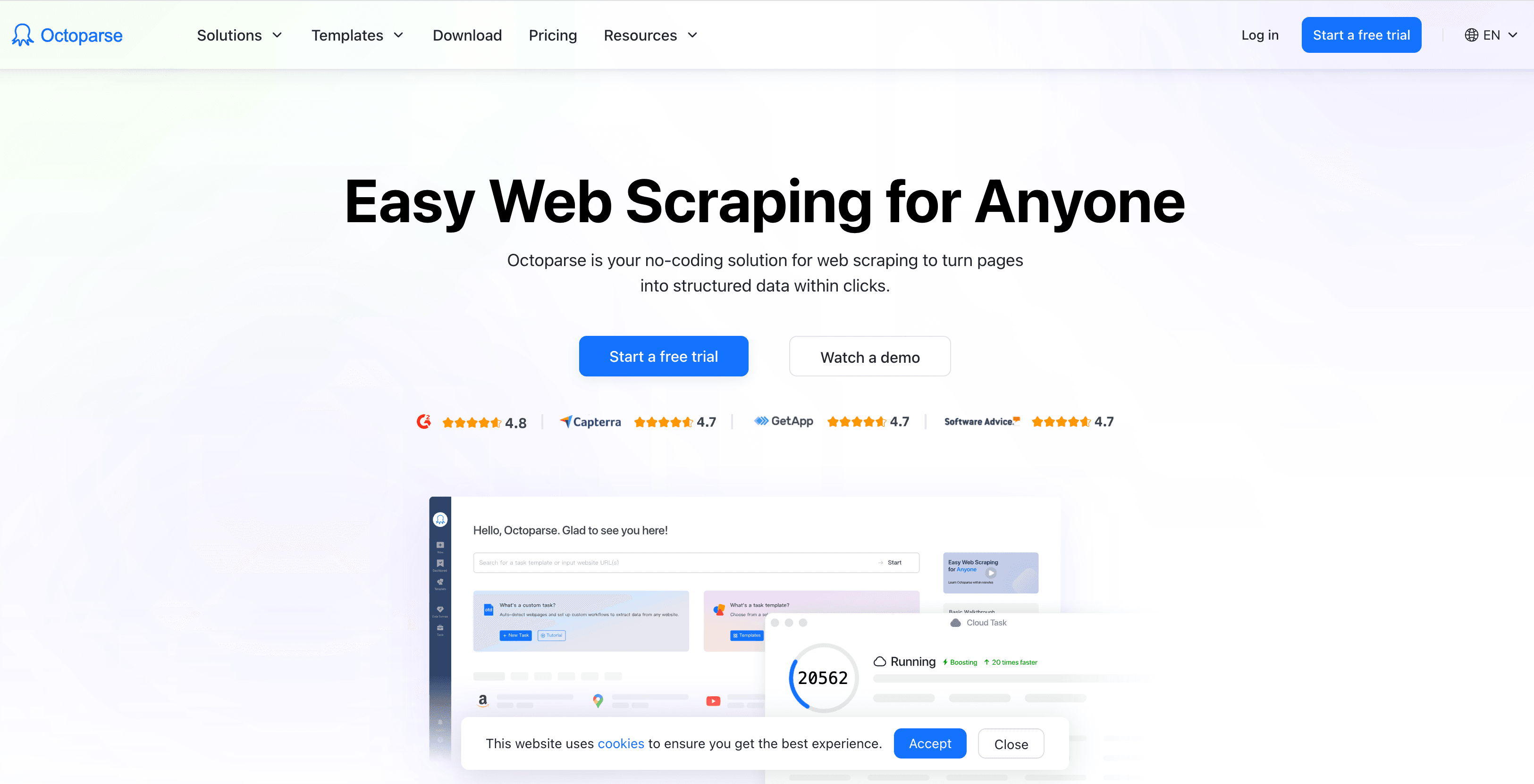
Octoparse has been around for a while and is a favorite among analysts and researchers who need to scrape complex websites—without writing code. It offers a visual, drag-and-drop workflow builder (desktop app for Windows/Mac, plus cloud service for paid users).
Key features:
- Huge template library for popular sites (Amazon, Twitter, job boards, etc.)
- Visual workflow builder—click to select fields, set up pagination, handle logins and AJAX
- Cloud scraping for scheduling and faster runs (paid)
- Handles dynamic content, infinite scroll, and multi-step workflows
Pricing: Free plan lets you scrape up to 10 tasks and 50,000 records/month (desktop only). Paid plans (starting ~$75/month) unlock cloud scraping, more tasks, and advanced features.
Best for: Analysts, researchers, and semi-technical users who want power and flexibility.
Pros:
- Handles very complex sites and interactions
- Huge template library saves time
- Active community and lots of tutorials
Cons:
- Learning curve for advanced workflows
- Cloud features cost extra
- Desktop app only (Win/Mac), no Linux
If you’re willing to invest a bit of time learning the workflow builder, Octoparse is a heavyweight in the no-code scraping world.
Browse AI: Flexible AI Web Scraping and Monitoring
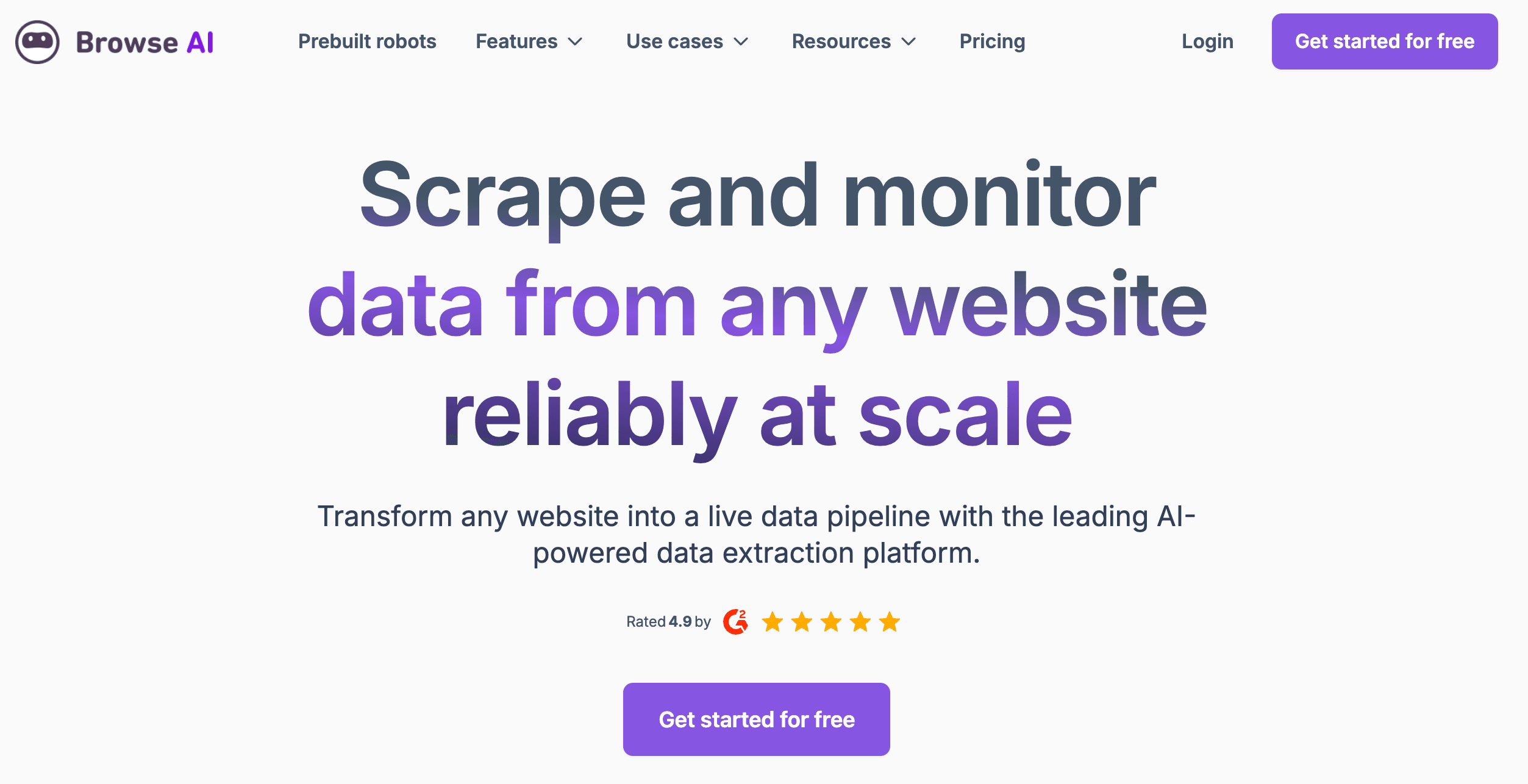
Browse AI is all about making web scraping and monitoring as easy as possible. You set up “robots” by pointing and clicking on the data you want, and Browse AI’s AI learns the pattern—no code required.
Key features:
- Point-and-click robot recorder
- AI adapts to site changes
- Scheduling and monitoring (detect content updates, get alerts)
- Direct integration with Google Sheets, Airtable, Zapier
Pricing: Free plan includes 50 credits/month. Paid plans start at $19/month (about 2,000 credits). Usage-based, so you pay for what you scrape.
Best for: Business users who need recurring data extraction or monitoring—think price trackers, new listings, or daily reports.
Pros:
- Super easy setup, even for non-techies
- Google Sheets integration is a game-changer for automation
- Responsive customer support
Cons:
- Usage-based pricing can add up for heavy users
- Not as granular for advanced developers
Browse AI is perfect if you want to automate repetitive checks or keep a finger on the pulse of your market—without writing a line of code.
Bardeen: Automate Data Collection with AI Playbooks
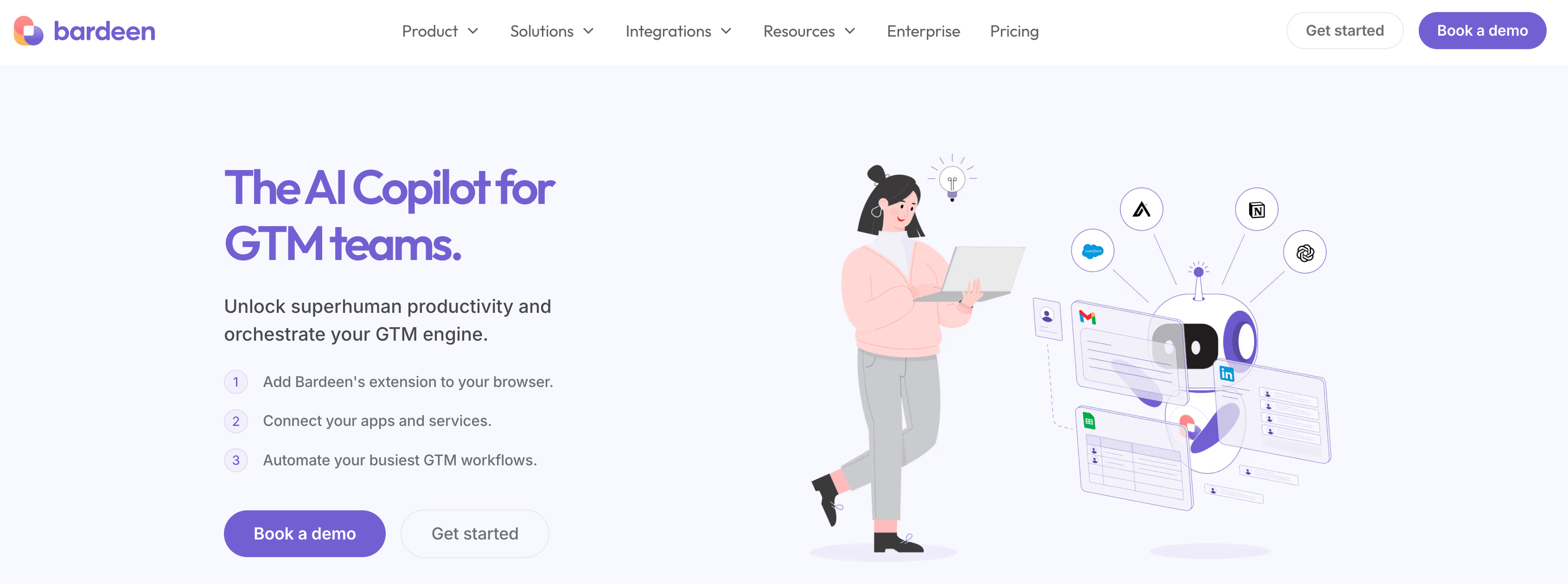
Bardeen isn’t just a scraper—it’s a Chrome extension for automating entire workflows, with scraping as one step. Think of it as your browser’s personal assistant.
Key features:
- AI-powered playbooks (automation recipes) for scraping and follow-up actions
- Integrates with Google Sheets, Notion, Slack, Trello, and more
- GPT-4 integration for content generation
- Can fill forms, execute multi-step tasks, and trigger actions automatically
Pricing: Generous free tier; paid plans for cloud execution and advanced features.
Best for: Power users, marketers, and anyone automating multi-step workflows (e.g., scrape leads, then add to CRM and send an email).
Pros:
- Automates scraping plus follow-up actions
- Free for most use cases
- Flexible and powerful
Cons:
- Learning curve for complex playbooks
- Scraping results may need review for accuracy
- Browser-based, so large jobs may require cloud execution
If you think in terms of “when X happens, do Y,” Bardeen is your new best friend.
ScrapeStorm: AI-Powered Data Extraction for All Skill Levels
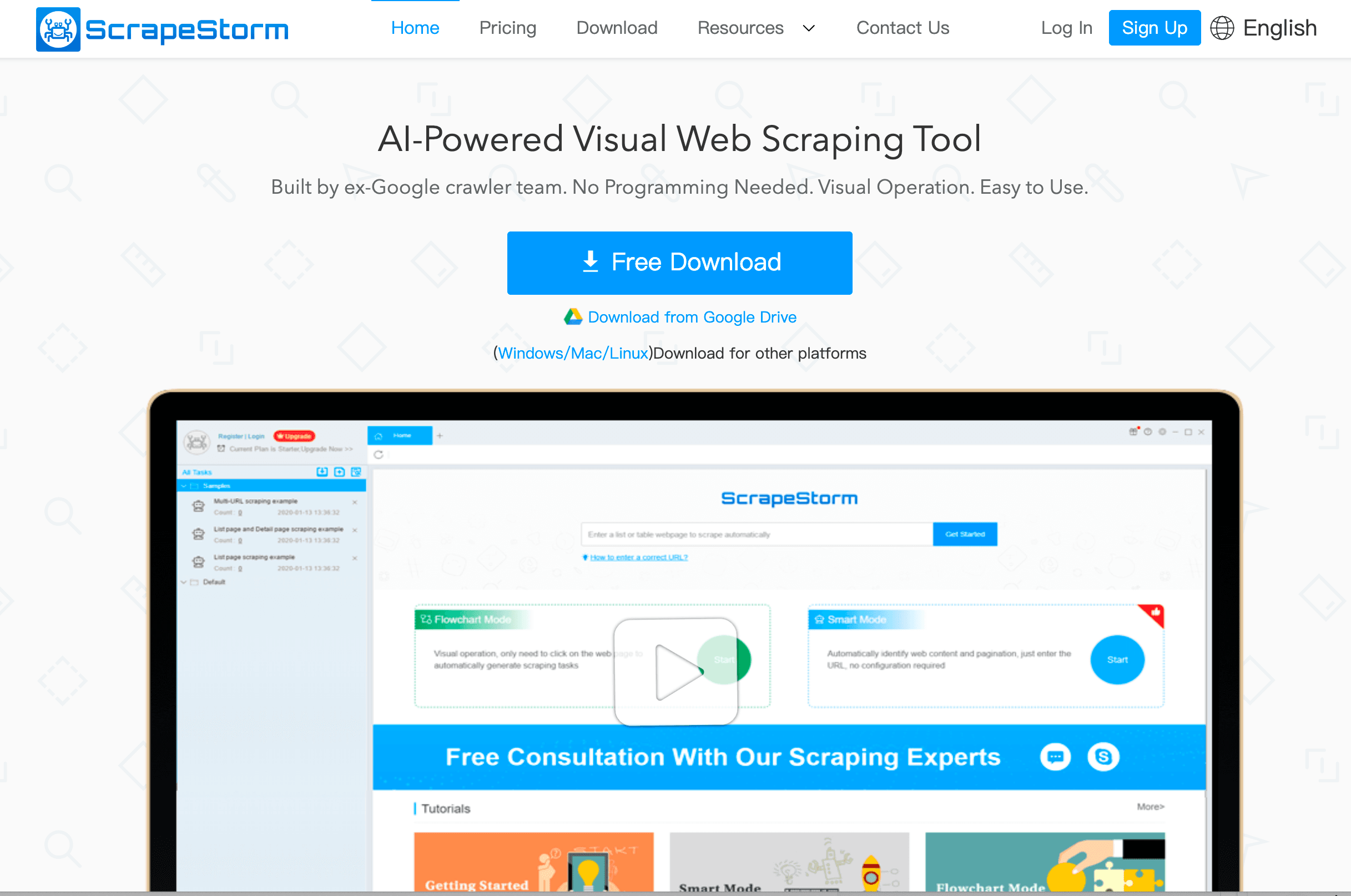
ScrapeStorm is a desktop app (Win/Mac/Linux) that caters to both beginners and advanced users with two modes: Smart Mode (AI auto-detection) and Flowchart Mode (custom workflows).
Key features:
- Smart Mode: Enter a URL, AI finds data and pagination automatically
- Flowchart Mode: Visual workflow builder for complex tasks
- Built-in rotating proxies and anti-blocking
- Scheduling, cloud runs, and multi-format exports
Pricing: Free tier (100 rows/day, 10 tasks); paid plans start at ~$50/month.
Best for: E-commerce, research, and anyone who needs both quick grabs and deep customization.
Pros:
- Visual interface is approachable
- Handles dynamic sites, images, and files
- Built-in proxies save hassle
Cons:
- Advanced features can be overwhelming for true beginners
- Free tier is limited for heavy use
ScrapeStorm is a solid choice if you want a tool that grows with your needs—from simple scrapes to complex, multi-step projects.
ScrapingBee: API-Driven AI Web Scraping for Developers
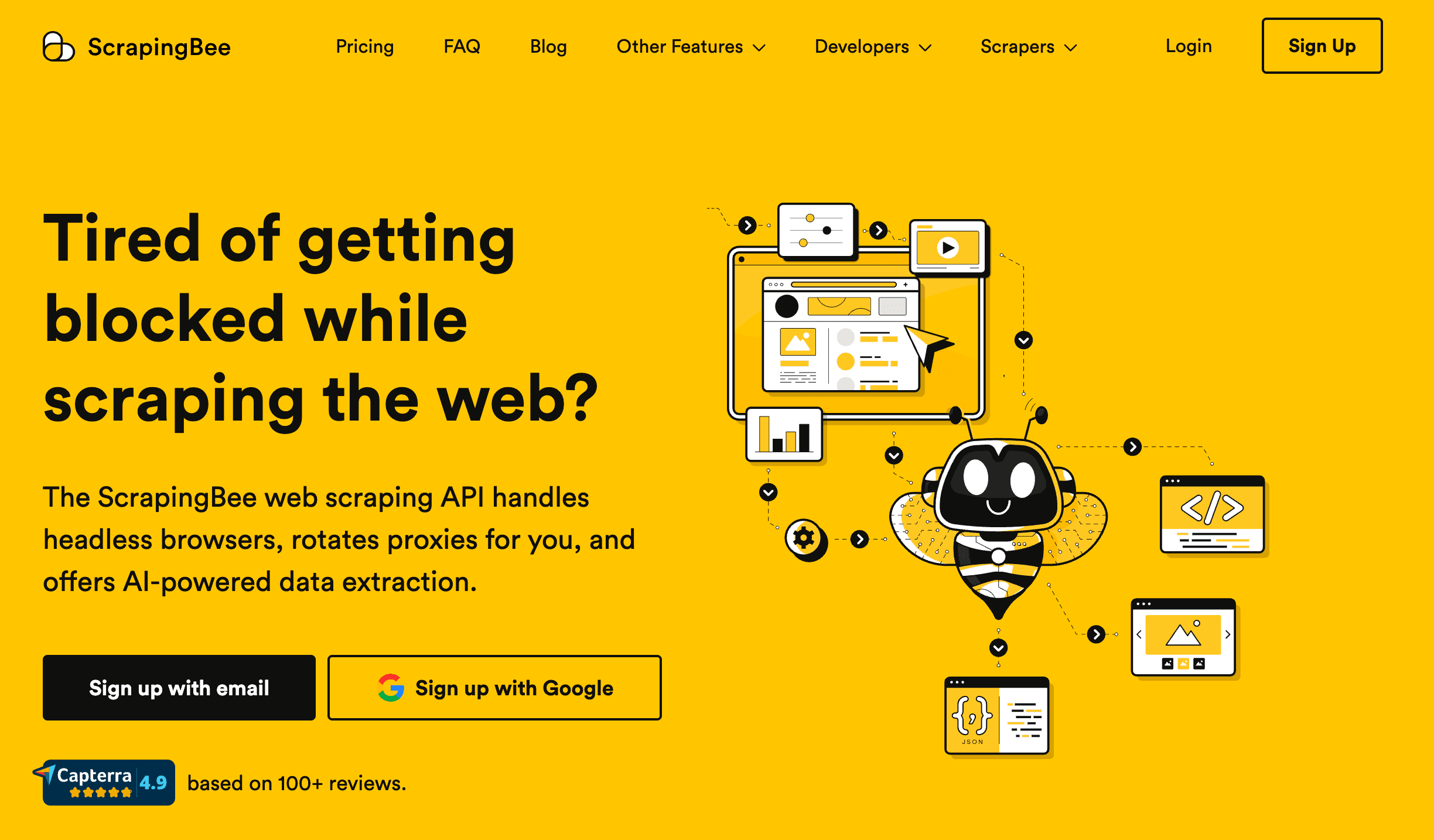
ScrapingBee is a developer’s dream: an API that handles headless browsers, proxies, and now, AI-powered data extraction.
Key features:
- API-first: fetch pages, handle JavaScript, proxies, CAPTCHAs
- AI Extraction: specify what data you want in plain language or JSON schema, get structured data back
- Scalable for large projects
Pricing: Paid plans start at $49/month for 100k API calls; AI extraction costs extra per request. Free trial available.
Best for: Developers, data engineers, and technical teams building custom pipelines.
Pros:
- Developer-friendly, fast, and reliable
- AI parsing reduces coding time
- Excellent documentation
Cons:
- Not for no-code users
- Usage-based pricing for heavy jobs
If you want to embed scraping into your app or workflow, ScrapingBee is a powerhouse—especially with the new AI extraction feature.
Import.io: Enterprise-Grade AI Data Extraction
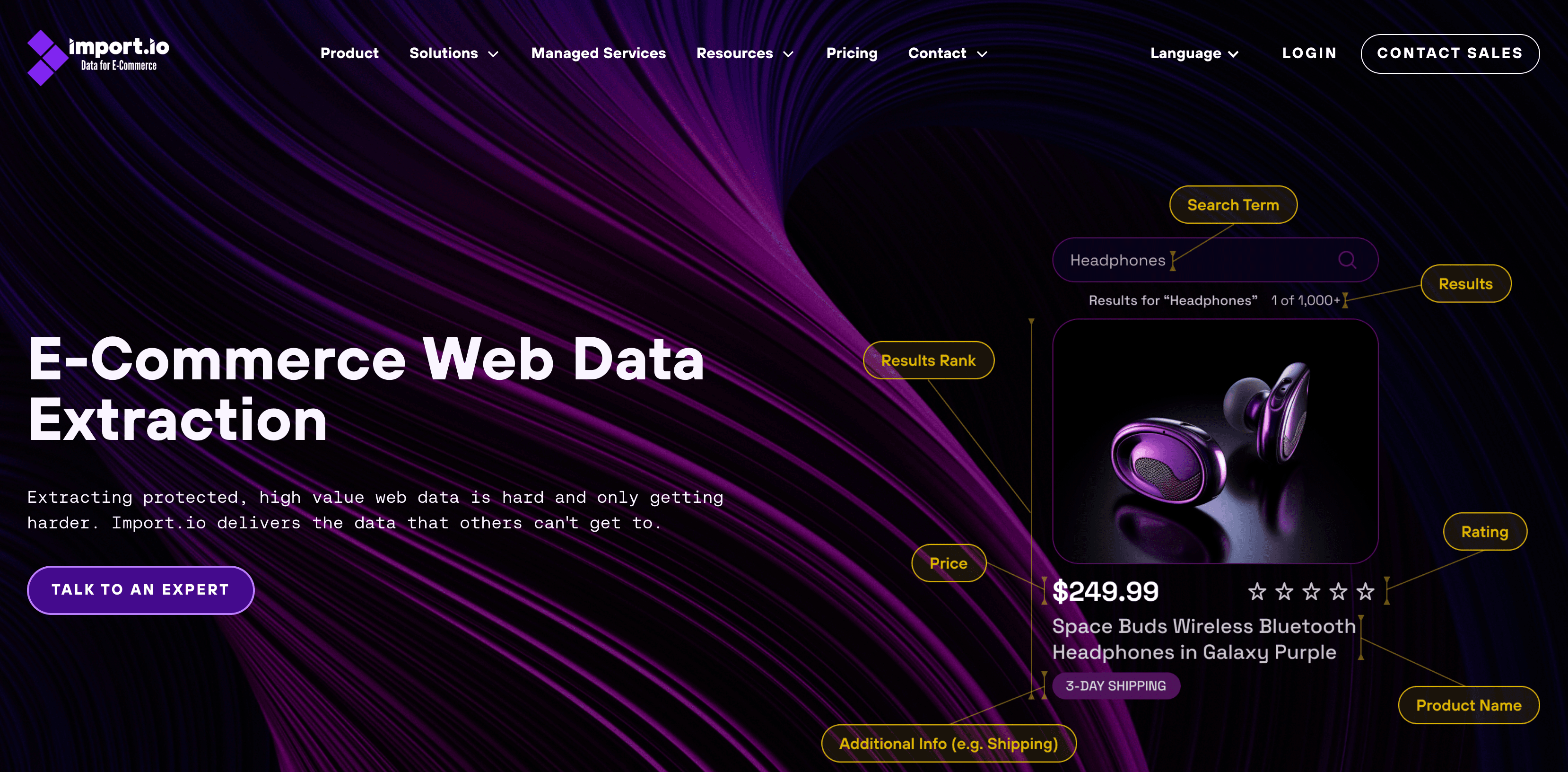
Import.io is the Rolls-Royce of web scraping platforms—feature-rich, scalable, and built for enterprise.
Key features:
- Machine learning extractors (auto-detects fields)
- Multi-page workflows, form filling, screenshot capture for compliance
- Chaining extractors for subpages
- Scheduling, API, and managed services
Pricing: Enterprise-level, custom pricing (think hundreds to thousands per month). No free plan.
Best for: Large organizations needing reliable, high-volume, compliance-focused data extraction.
Pros:
- Scalable and robust
- Compliance and audit features
- Managed services available
Cons:
- Expensive, not for small teams
- Learning curve for DIY users
If data is mission-critical and you need support, compliance, and scale, Import.io is a top choice.
ParseHub: Visual AI Web Scraper for Complex Sites
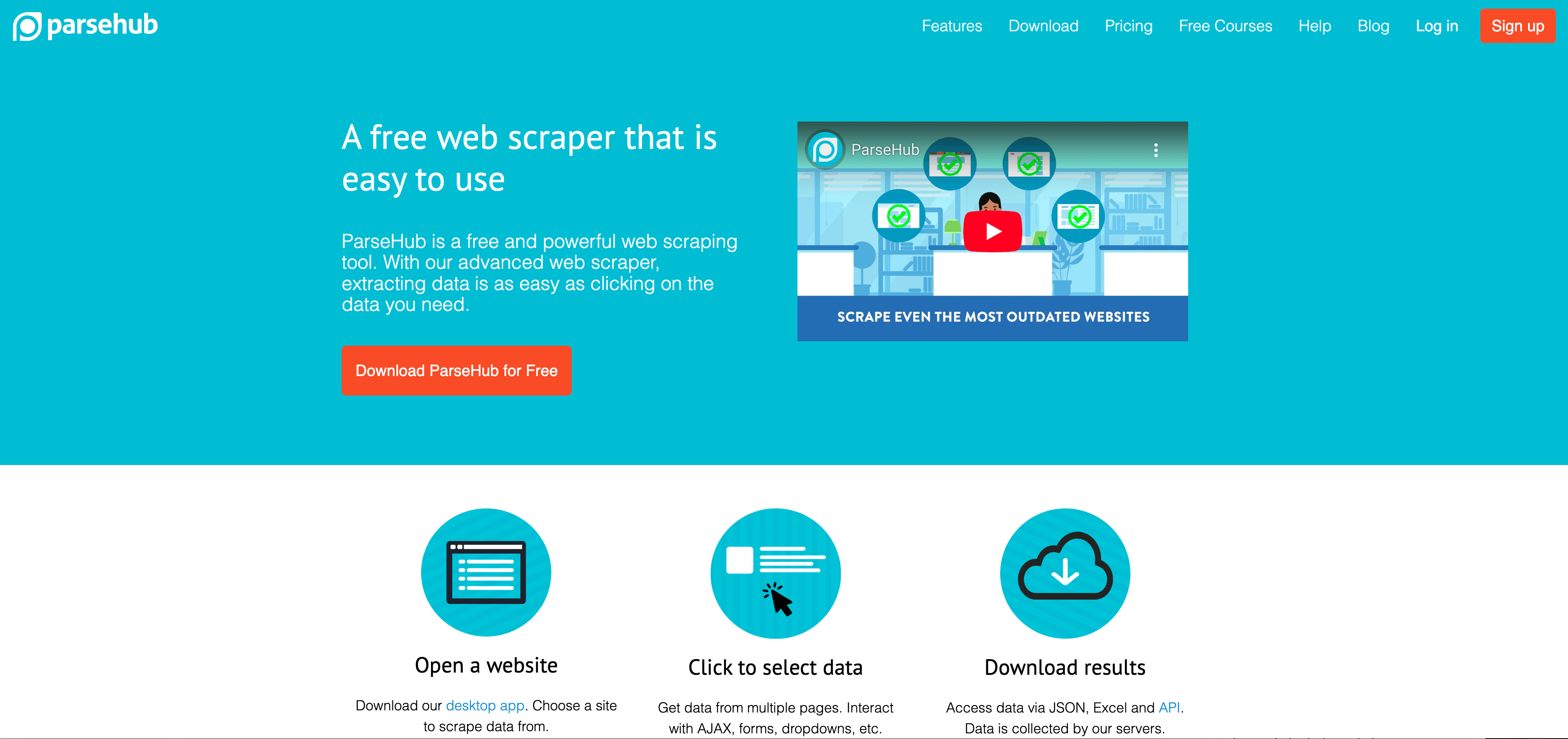
ParseHub is a free-to-start desktop app (Win/Mac/Linux) known for handling complex, dynamic sites.
Key features:
- Visual interface for selecting elements and defining actions
- Handles JavaScript-heavy sites, infinite scroll, conditional logic
- Scheduling and cloud runs (paid)
- Regex and scripting for advanced users
Pricing: Free plan (5 projects, 200 pages/run); paid plans start at $149/month.
Best for: Semi-technical users, researchers, and anyone scraping tricky sites.
Pros:
- Powerful for complex workflows
- Free tier is generous
- Cross-platform
Cons:
- Clunky UI, learning curve
- No built-in proxies
- Manual maintenance for site changes
ParseHub is great if you need to scrape sites that break simpler tools—but be ready to invest some time learning the ropes.
Kadoa: AI Scraper with Data Cleansing and Monitoring
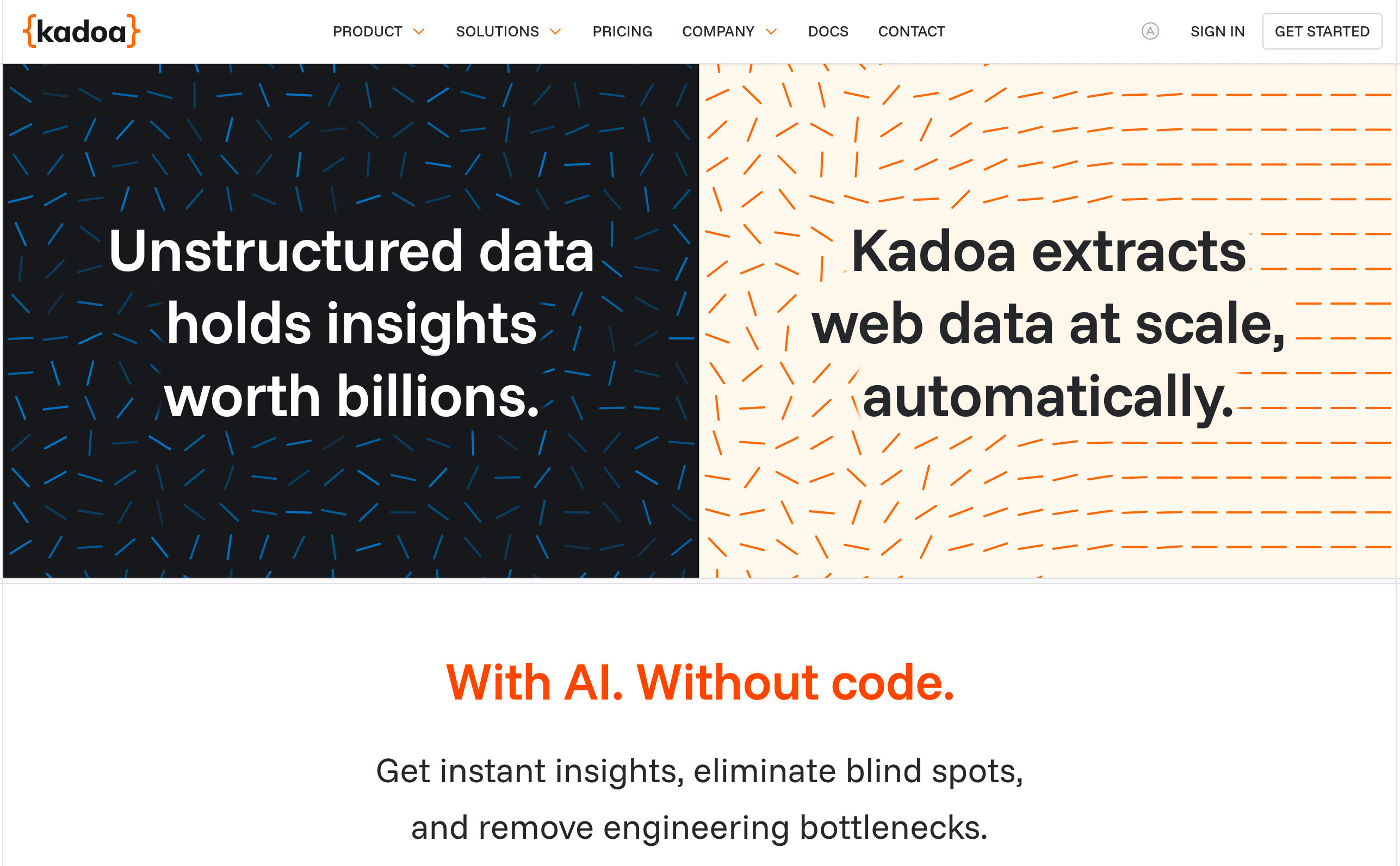
Kadoa is a no-code, AI-powered platform focused on end-to-end data extraction, cleaning, and real-time monitoring.
Key features:
- Self-healing scrapers (AI adapts to site changes)
- Real-time monitoring and instant alerts
- Data cleansing and normalization (dates, prices, units)
- Scalable for millions of data points daily
Pricing: Enterprise-focused, custom pricing. Free trial available.
Best for: Finance, e-commerce, job data, and teams needing continuous, clean data.
Pros:
- Self-healing reduces maintenance
- Fast alerts for real-time monitoring
- Data normalization built-in
Cons:
- Expensive, aimed at enterprise
- Newer platform, evolving features
If you need up-to-the-minute, clean data—and want to spend less time fixing broken scrapers—Kadoa is worth a look.
Scrapy: Open-Source Web Scraper for Developers
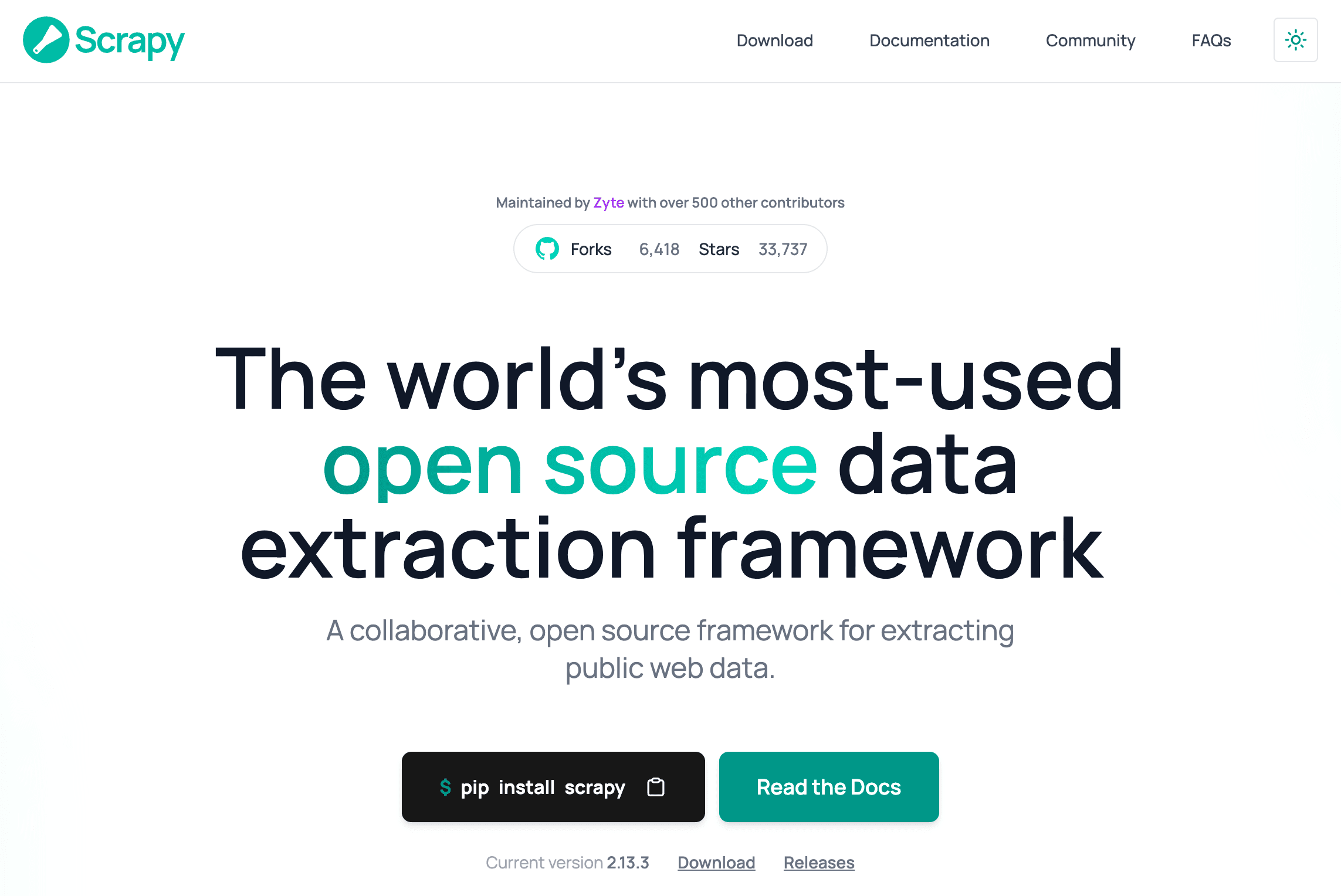
Scrapy is the open-source Python framework that’s powered countless scraping projects for over a decade.
Key features:
- Custom spiders for full control
- Scalable, fast, and memory-efficient
- Massive plugin ecosystem
- Free and open source
Pricing: Free (but you manage your own infrastructure).
Best for: Developers, data engineers, and anyone who wants total control.
Pros:
- Unlimited flexibility
- Huge community and support
- Integrates with Python data pipelines
Cons:
- Coding required
- Maintenance is on you
- No built-in AI (but you can integrate your own)
If you know Python and want to build custom scrapers, Scrapy is still the gold standard.
Webscraper.io: Browser-Based Web Scraper for Beginners
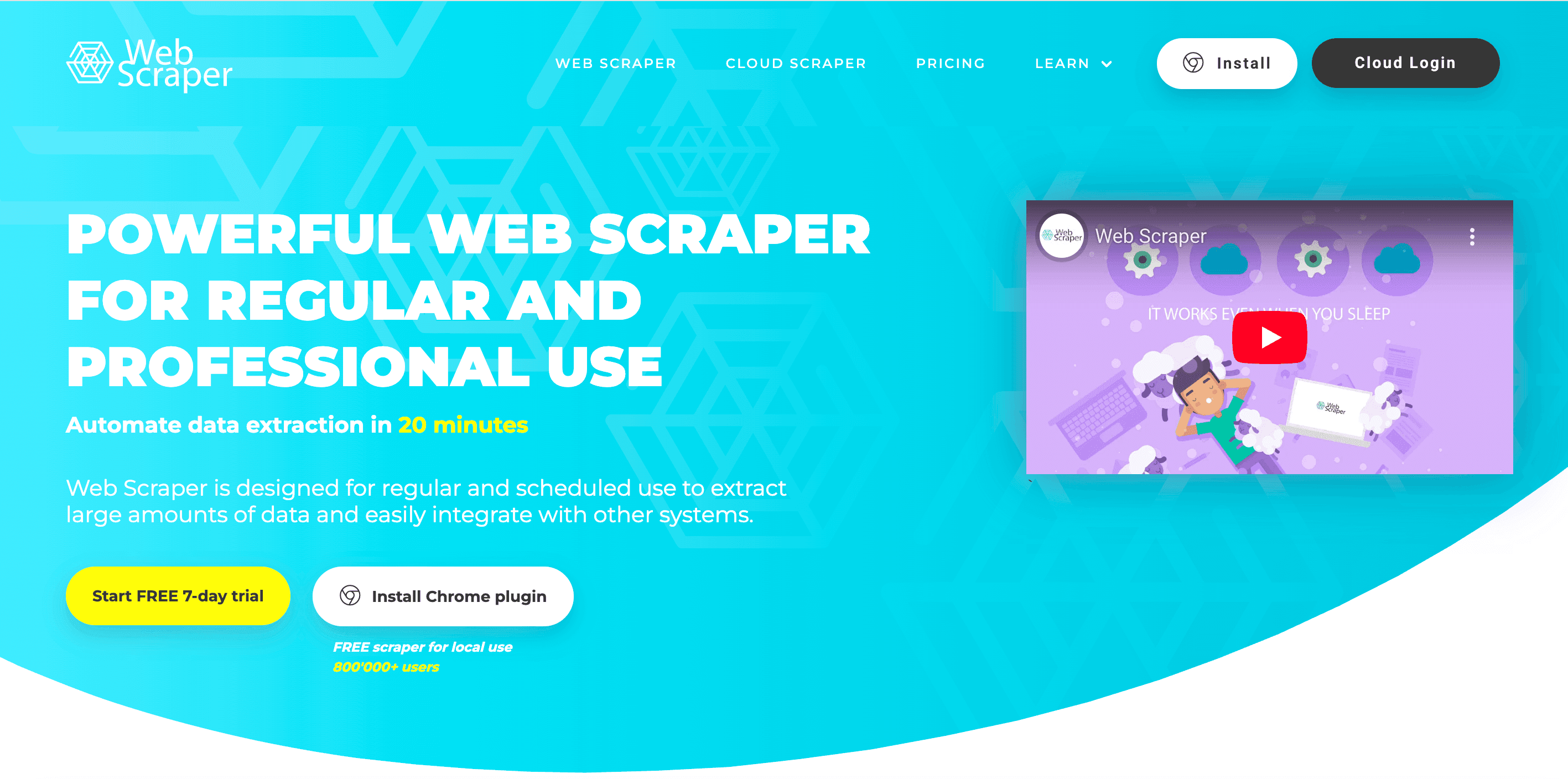
Webscraper.io is a free Chrome/Firefox extension that’s perfect for beginners.
Key features:
- Point-and-click sitemap builder
- Handles lists, pagination, subpages
- Exports to CSV/JSON
- Community sitemaps and tutorials
Pricing: Free for local use; paid cloud plans for scheduling and automation.
Best for: Non-technical users, students, and anyone with simple scraping needs.
Pros:
- Free and easy to use
- Community support
- Good for small, static sites
Cons:
- No AI or anti-bot features
- Limited for dynamic/complex sites
- Runs in your browser (manual for large jobs)
If you’re just getting started or need a quick data grab, Webscraper.io is a great entry point.
Diffbot: AI-Powered Structured Data Extraction
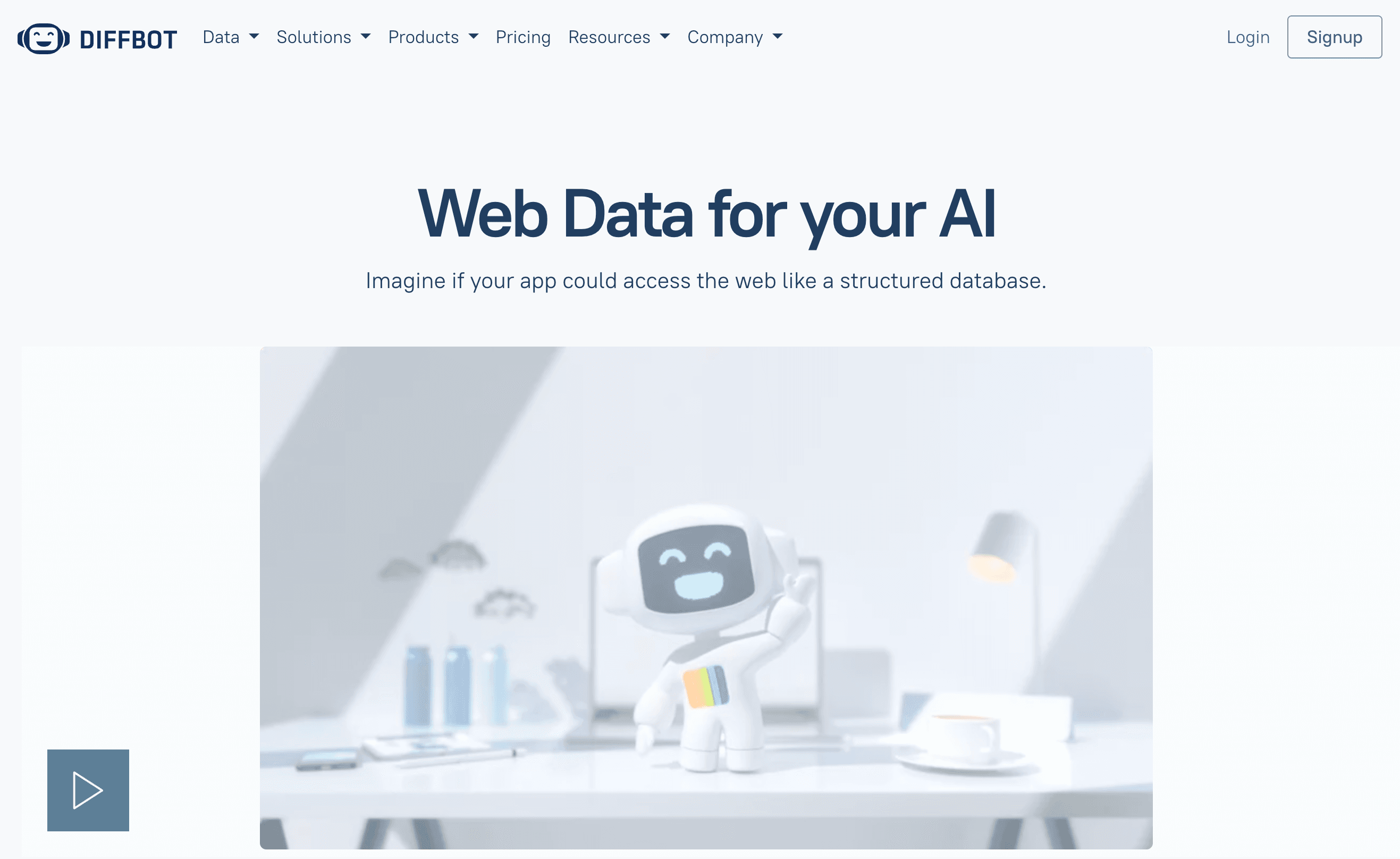
Diffbot is a unique, AI-powered service that turns the web into a structured database—no setup required.
Key features:
- AI/NLP/computer vision extractors for articles, products, forums, etc.
- Knowledge Graph with billions of entities
- API for structured data from any URL
- Handles images, natural language, and more
Pricing: Enterprise pricing, starts at $299/month for fixed credits. Free trial available.
Best for: Enterprises, research, media monitoring, and anyone needing broad, automated coverage.
Pros:
- No setup—just send URLs, get structured data
- Extremely broad coverage
- Knowledge Graph for advanced queries
Cons:
- Expensive
- Less control for custom fields
- Occasional misclassification on weird pages
If you want to turn the web into a database and budget isn’t a concern, Diffbot is unmatched.
AIScraper: Fast AI Web Scraping for Lead Generation
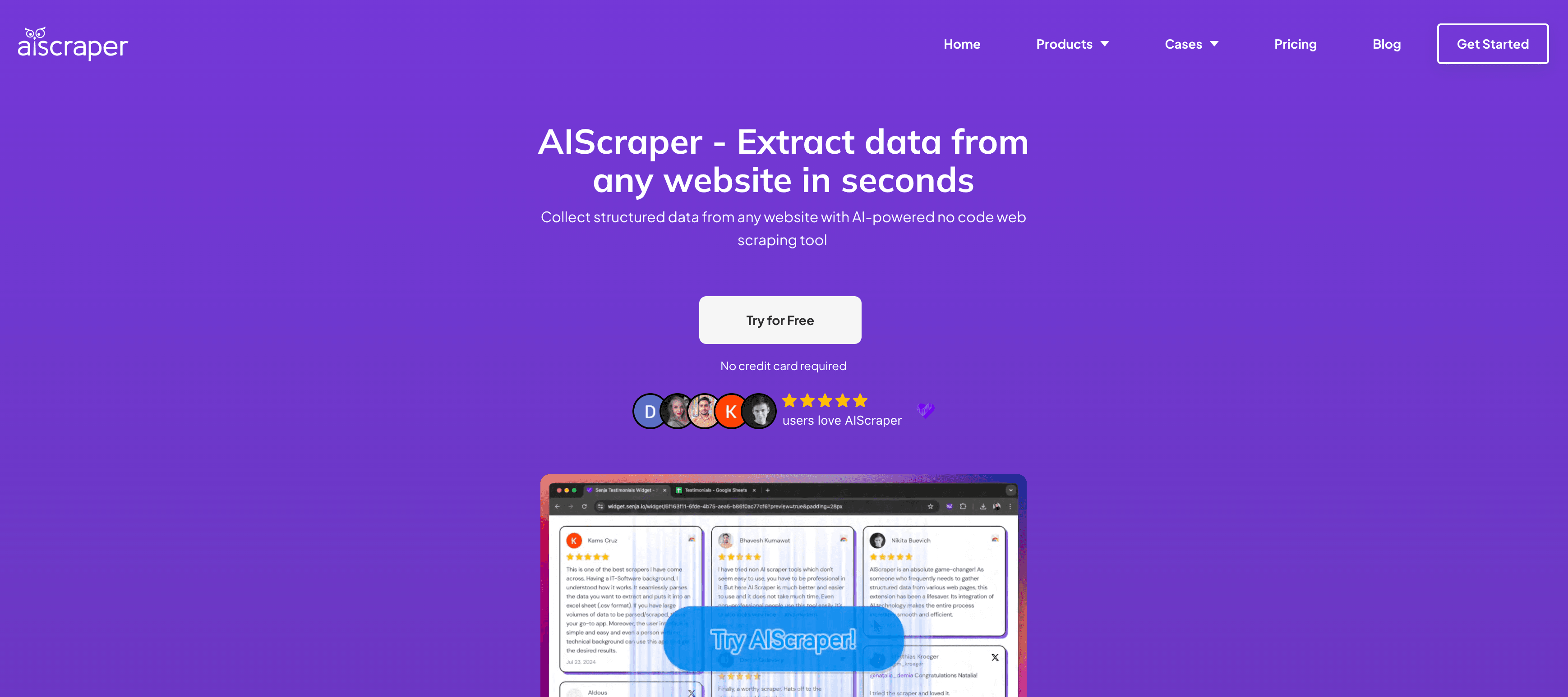
AIScraper is a Chrome extension focused on quick, AI-powered scraping—especially for lead generation.
Key features:
- Natural language prompts (“scrape all job titles and companies on this page”)
- Presets for job boards, real estate, marketplaces
- Subpage scraping, instant exports to CSV/JSON/Sheets
- Pay-as-you-go credits
Pricing: Credits start at $6 for 200; no subscription required.
Best for: Sales, recruiters, entrepreneurs, and anyone who needs quick, on-demand data.
Pros:
- Super fast setup (~8 seconds per page)
- Affordable, pay only for what you use
- Easy for non-tech users
Cons:
- Not for huge jobs or crawling entire sites
- Browser-based, so manual for large lists
If you’re tired of copy-pasting leads, AIScraper is a lifesaver.
Gumloop: AI Web Scraping for Custom Data Workflows
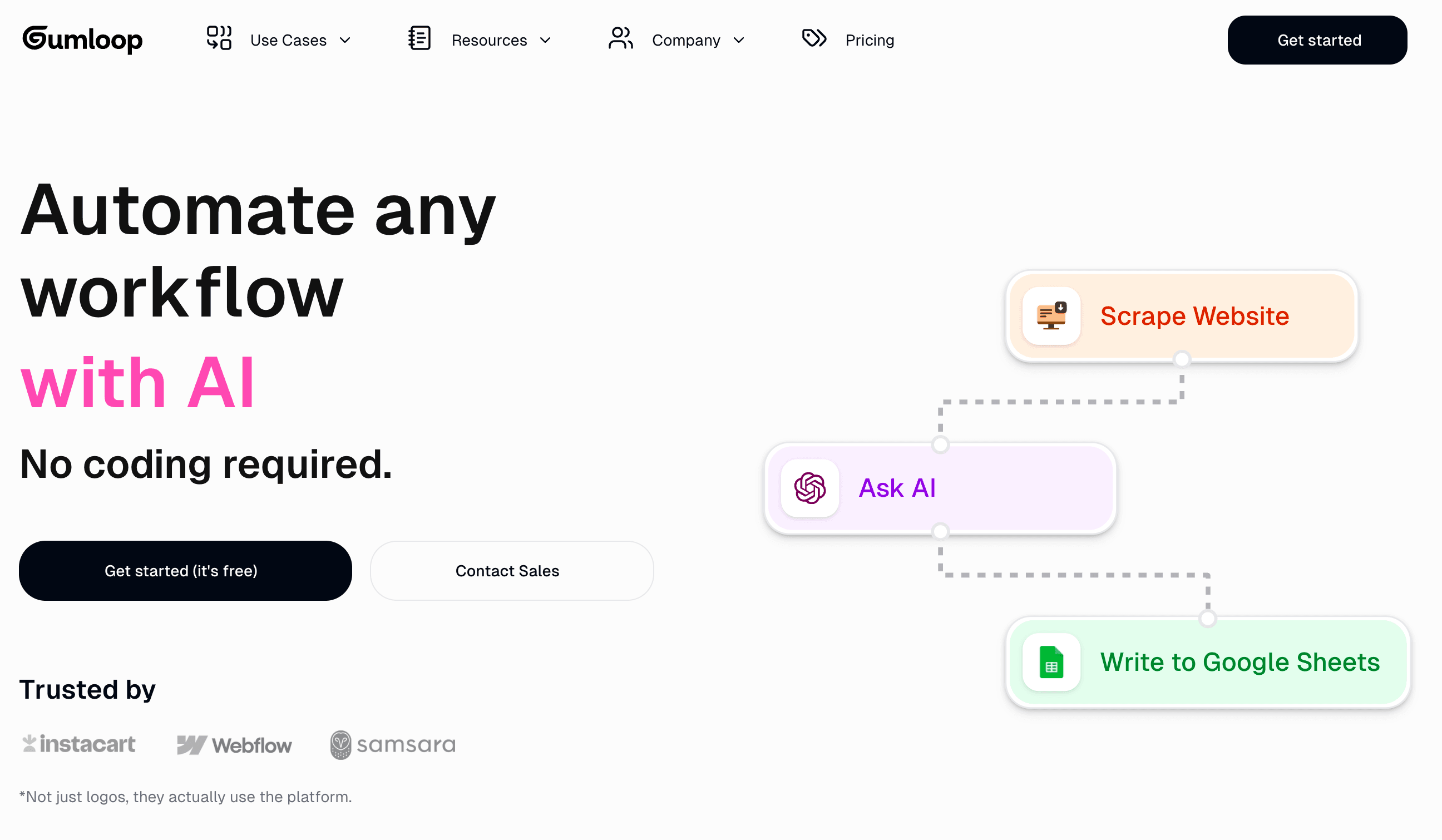
Gumloop is a visual automation platform that lets you build custom, AI-powered workflows—including scraping, data processing, and integrations.
Key features:
- Visual workflow builder with drag-and-drop nodes
- AI-driven data extraction, Chrome recorder
- Integrates with Gmail, Slack, Sheets, HubSpot, and more
- Conditional logic, loops, and multi-step automations
Pricing: Starter plan $97/month; Pro $297/month. Free trial available.
Best for: Tech-savvy teams, growth ops, and anyone automating multi-step processes.
Pros:
- Highly flexible, handles complex workflows
- AI nodes for unstructured data
- Chrome recorder for capturing actions
Cons:
- Pricey for small teams
- Learning curve for advanced automations
If you want to automate more than just scraping—think full business processes—Gumloop is a powerful option.
scrapeless: AI Scraper with Emphasis on Simplicity
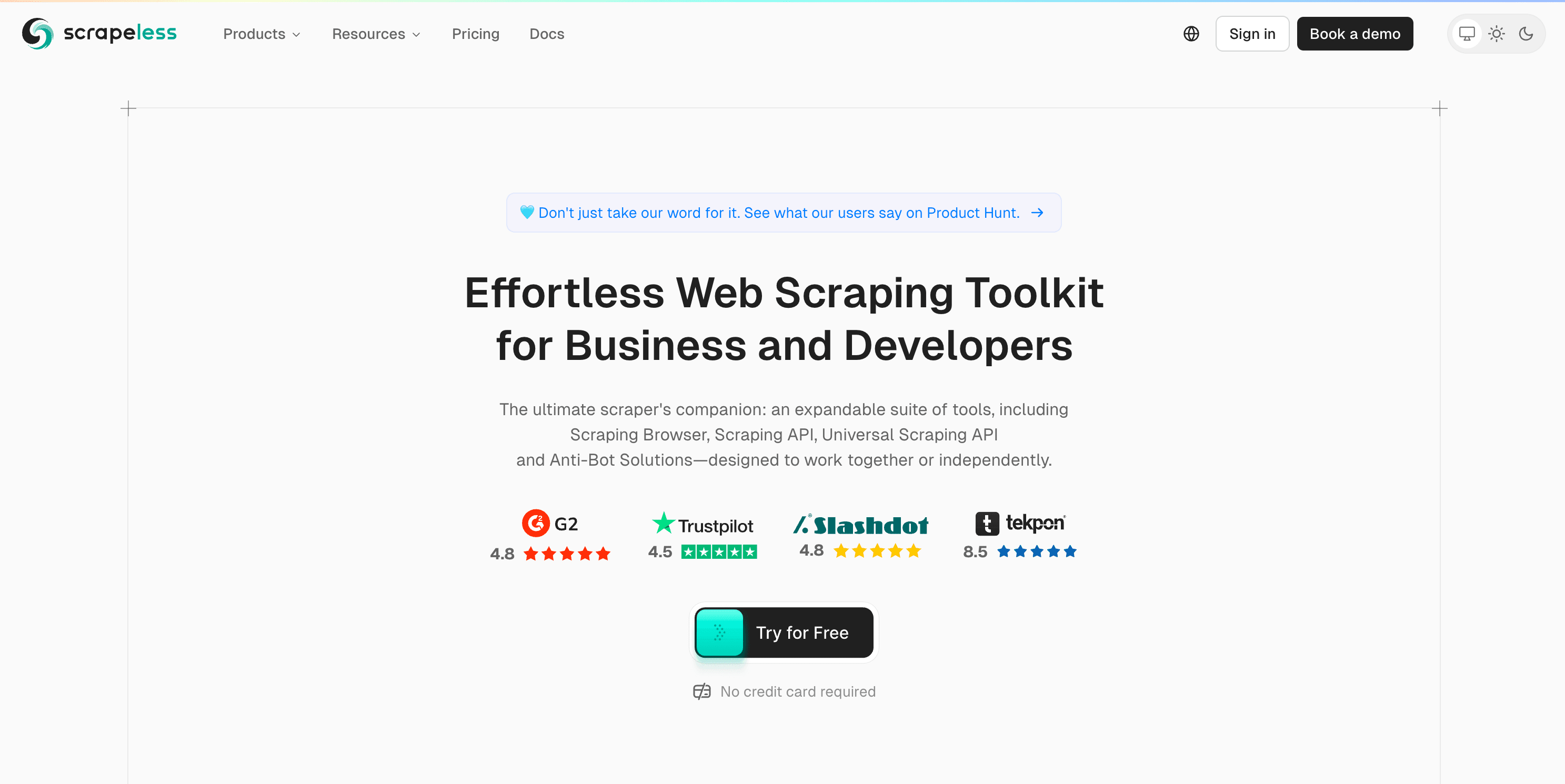
scrapeless is a toolkit and API that aims to make web data extraction as simple as possible—no scraping headaches required.
Key features:
- AI-powered scraping API (one call = structured data)
- Real browser rendering, anti-bot, proxy pool
- Data cleaning, real-time feeds, pay-per-success pricing
- Developer-friendly, scalable for big jobs
Pricing: Usage-based, pay only for successful requests. Free trial available.
Best for: Developers, startups, and businesses who want a simple, scalable API.
Pros:
- Simple API, robust anti-blocking
- Scalable for large projects
- Data cleaning and transformation built-in
Cons:
- Smaller community
- Some features may be enterprise-only
If you want to focus on what data you need—not how to get it—scrapeless is a strong contender.
Oxylabs: AI Web Scraper Copilot for API-Based Data Extraction
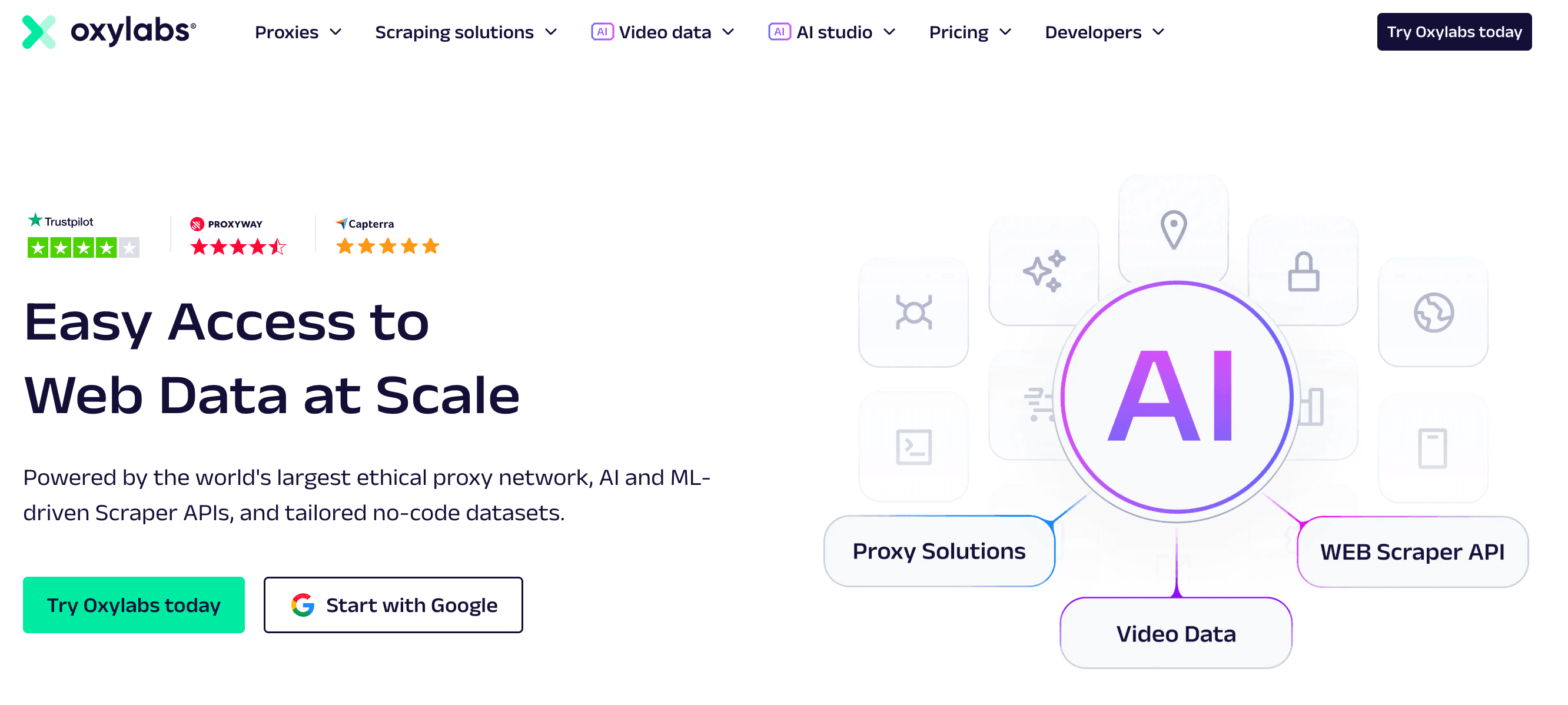
Oxylabs is an enterprise-grade provider known for its massive proxy network and robust scraping APIs. Their new OxyCopilot brings AI to the party.
Key features:
- Web Scraper API with 100M+ proxies, headless browser, anti-bot
- OxyCopilot AI assistant: generate scraping code or extraction rules from natural language
- Analytics dashboard, 24/7 support, compliance features
Pricing: Enterprise pricing, starts at ~$99/month for micro plans. Free trial available.
Best for: Enterprises, technical teams, and anyone scraping at massive scale.
Pros:
- Enterprise-grade reliability and support
- AI Copilot speeds up development
- Handles even the toughest sites
Cons:
- Expensive, not for small jobs
- Requires technical know-how for integration
If you’re scraping millions of pages and want the best infrastructure (plus AI to help), oxylabs is a top-tier solution.
Which AI Scraper Is Best for Your Data Extraction Needs?
With so many strong options, how do you choose? Here’s my quick cheat sheet:
- Non-technical users / small teams: , Browse AI, AIScraper, Webscraper.io
- Growth hackers / marketers: Bardeen, Gumloop
- Developers / technical users: Scrapy, ScrapingBee, scrapeless
- Enterprise / large-scale: Import.io, Diffbot, oxylabs
- E-commerce / competitor monitoring: ScrapeStorm, ParseHub
- Real estate / jobs data: AIScraper, scrapeless, Diffbot
Pro tip: Try a few tools with your real data before committing. Most offer free trials or credits. Check user reviews, and don’t be afraid to mix and match—many teams use a combination (e.g., Thunderbit for quick grabs, ScrapingBee for backend jobs).
And always, always use these tools responsibly—respect website terms, privacy, and data ethics.
Conclusion: Supercharge Your Data Collection with the Right AI Web Scraper
If you’ve made it this far, congrats—you’re now armed to the teeth for the data gold rush of 2025. AI web scrapers have lowered the barrier to web data extraction so much that even my mom could build a lead list (and she still calls me to fix her Wi-Fi). Whether you’re a solo entrepreneur or running a Fortune 500 data team, there’s a tool here that can save you hours, boost your insights, and maybe even make you look like a wizard at the next team meeting.
So, what’s next? Pick an AI scraper, run a pilot on your toughest data problem, and see how much time you save. Check out the for more deep dives, or grab the to get started in two clicks.
Remember: in the world of data, speed and accuracy are everything. With the right AI scraper, you’ll spend less time wrangling data and more time making decisions that move the needle. And if you ever find yourself missing the “good old days” of copy-paste, just remember—there’s probably an AI for that now, too.
Happy scraping, and may your spreadsheets always be clean!
FAQs
1. What is an AI web scraper and how does it differ from traditional scrapers?
An AI web scraper uses artificial intelligence—like machine learning, NLP, and computer vision—to extract data from websites automatically. Unlike traditional scrapers, which require manual setup and coding, AI scrapers can detect and extract meaningful data even when websites change layout or use dynamic content. They’re faster, more adaptive, and accessible to non-developers.
2. Who should use AI web scraping tools?
AI web scraping tools are ideal for sales teams, marketers, ecommerce businesses, real estate professionals, researchers, and data analysts—basically anyone who needs structured data from websites without coding. Whether you're building lead lists, tracking prices, or monitoring competitors, AI scrapers make the process easier and faster.
3. What are the key features to look for in an AI scraper?
Important features include no-code or low-code interfaces, AI field detection, support for subpages and pagination, dynamic content handling, export and integration options (e.g. Google Sheets, Airtable), scheduling, data cleaning, and compliance tools. The right combination depends on your goals and technical skill level.
4. Which AI scraper is best for non-technical users?
Thunderbit, Browse AI, AIScraper, and Webscraper.io are highly recommended for non-technical users. Thunderbit stands out for its simple Chrome extension, AI-suggested fields, subpage handling, and instant export features—all designed for ease of use without sacrificing power.
5. Is there a free plan for most AI web scraping tools?
Yes, most tools offer a free plan or trial, including Thunderbit, Octoparse, Browse AI, and ParseHub. However, the limitations vary—some restrict the number of pages you can scrape, while others limit export formats or scheduling. It’s best to try a few with your own use case before committing to a paid plan.
Want to learn more? Check out these related guides: